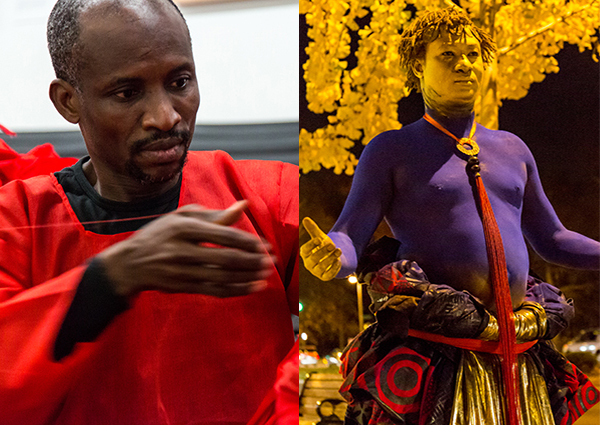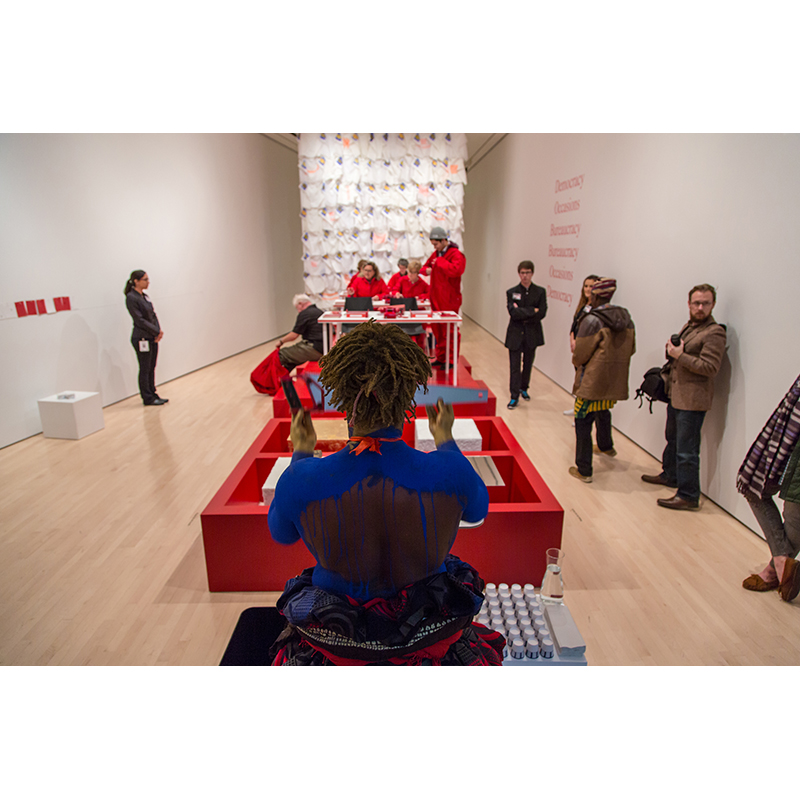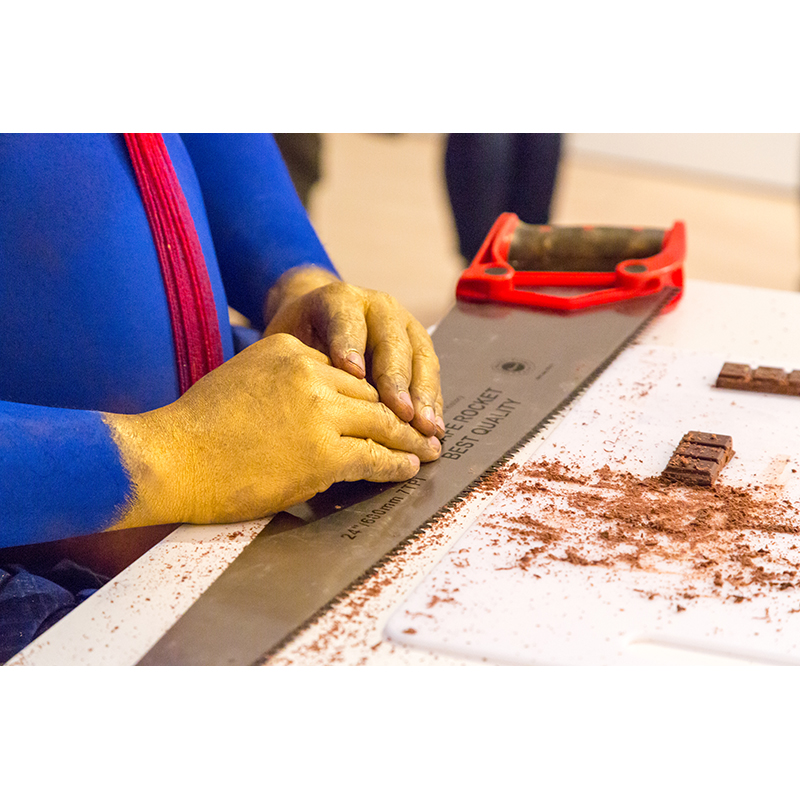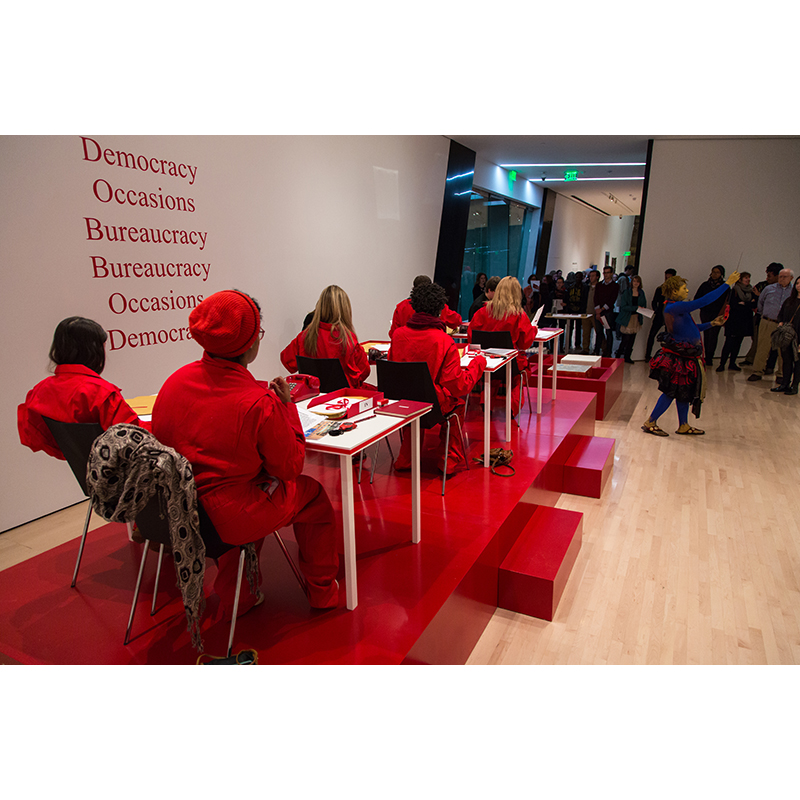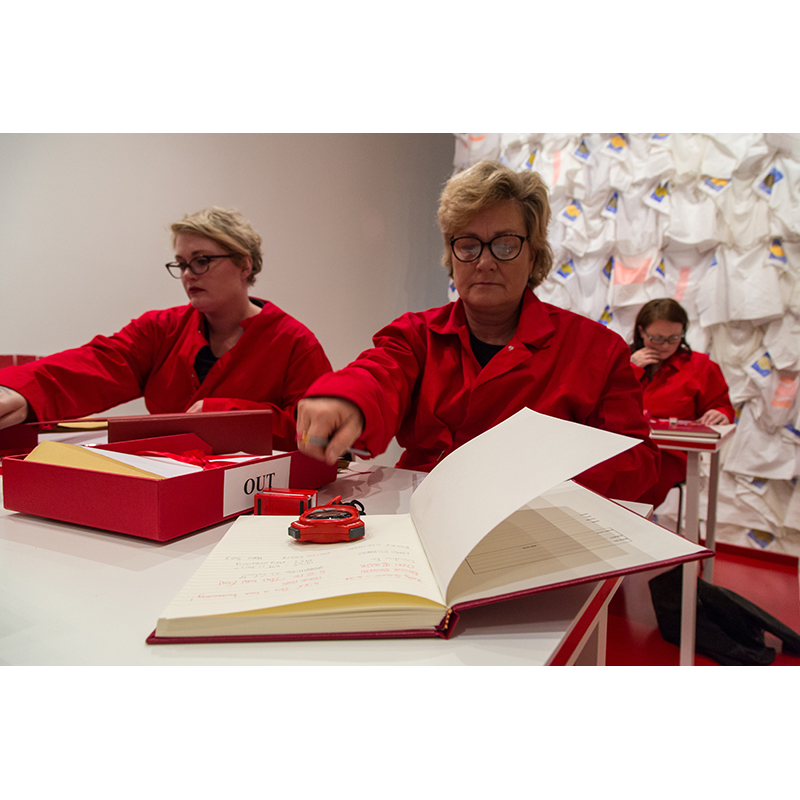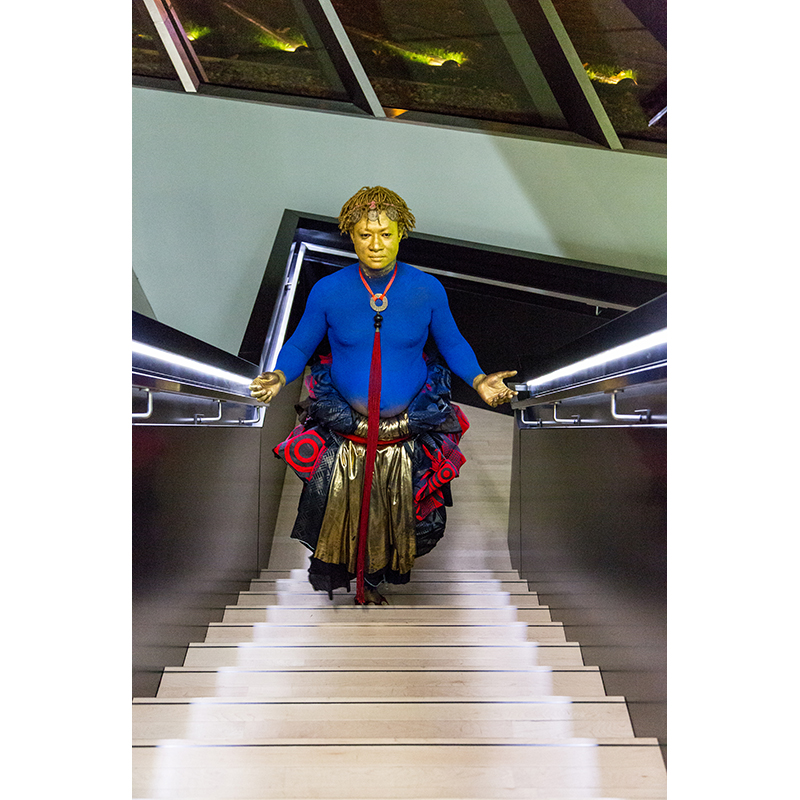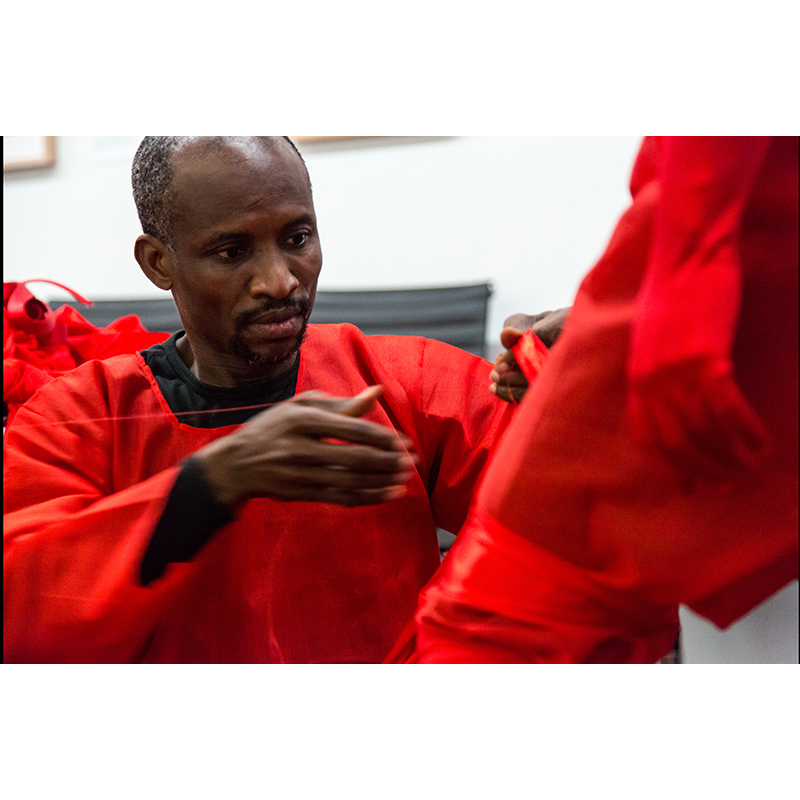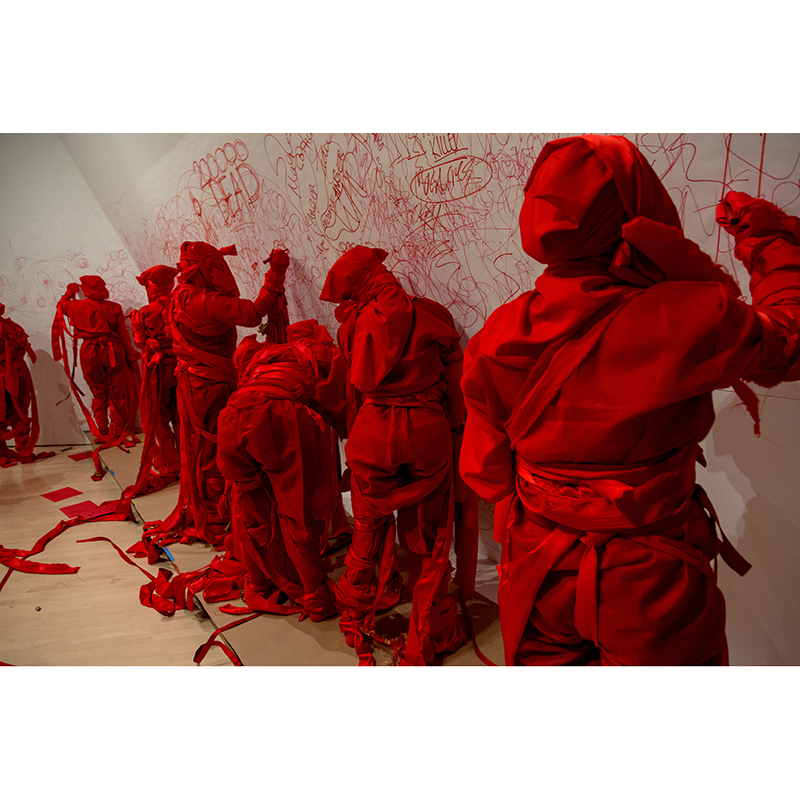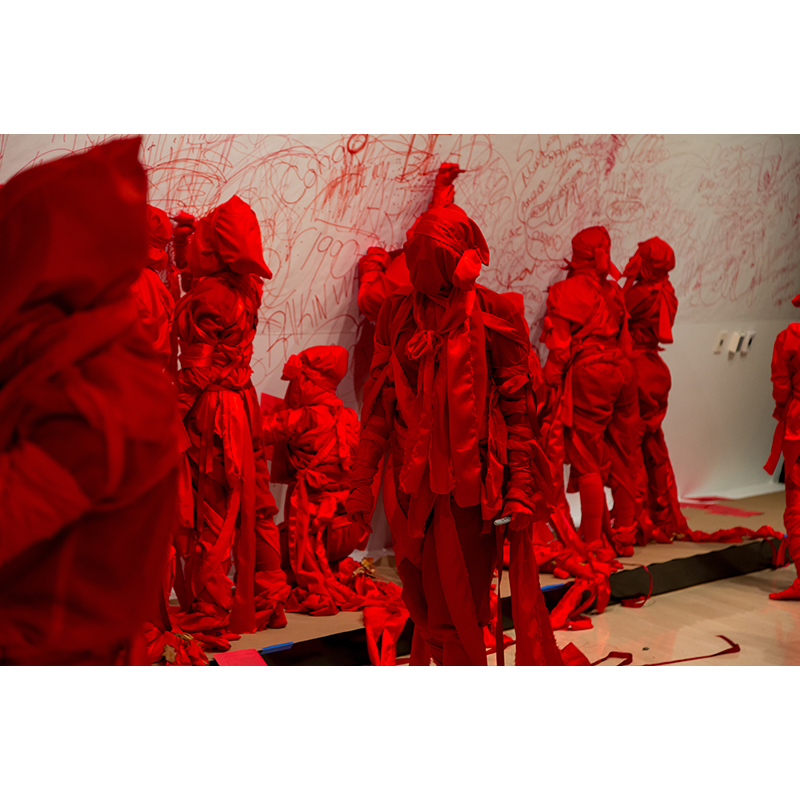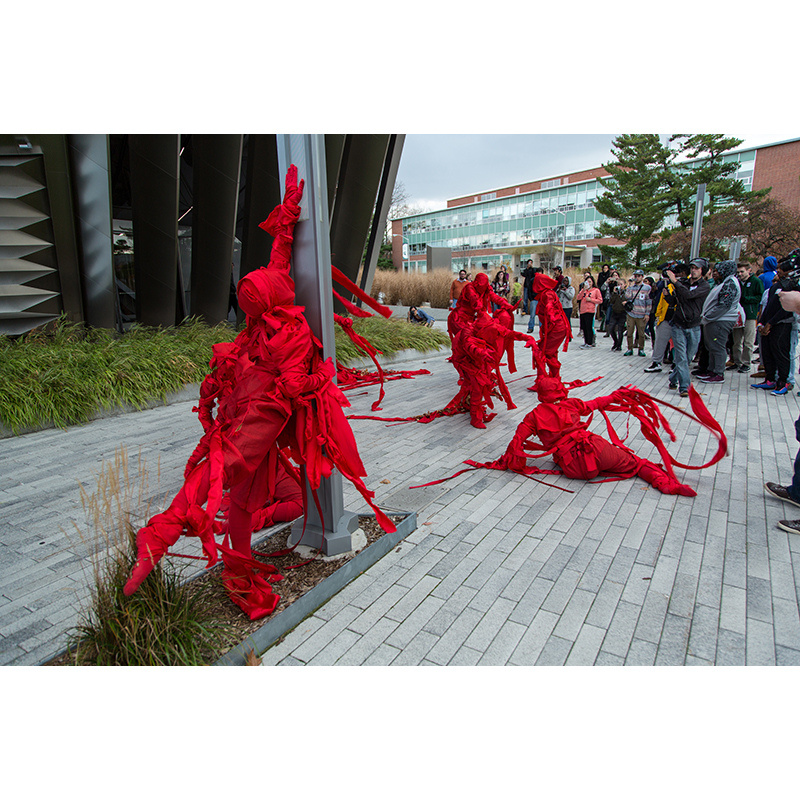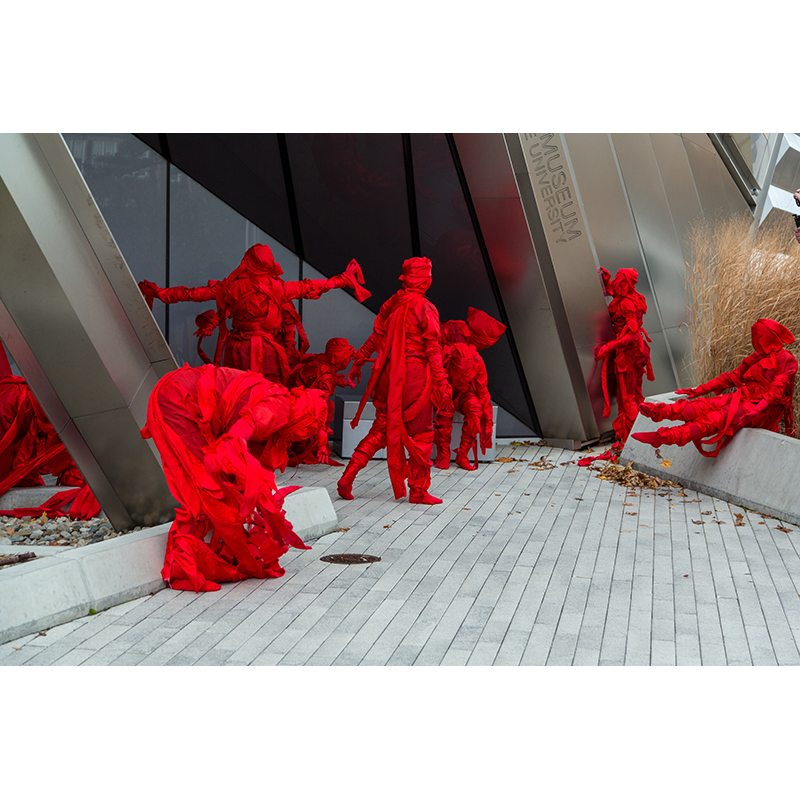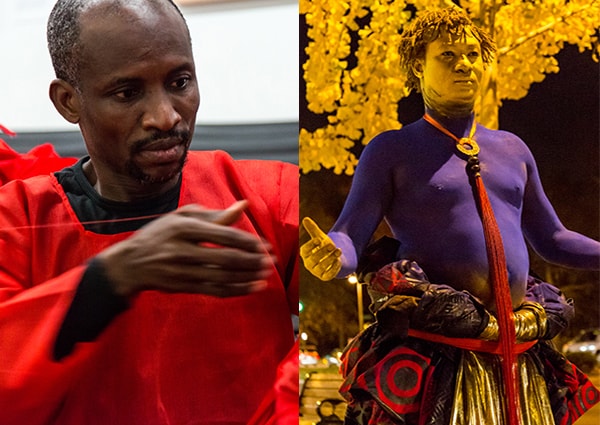
Artists reflect on the world through the objects and experiences they create. The choice of material, the site of actions, and the physical or thematic elements incorporated into a work all provoke questions about the individual and collective experience of what it means to be human in contemporary society. Recent terrorist attacks perpetrated by Daesh (ISIS) and other groups in Beirut, Bamako, northeastern Nigeria, Baghdad, and Paris make issues like safety and security, poverty, and access to healthcare and education feel more pressing. Given this rising global trend in xenophobia and radicalism, we might also feel a more urgent need for nuanced discussions around expressions of cultural specificity and political difference. Material Effects: Contemporary Art from West Africa and the Diaspora, an exhibition exploring the legacy of Laboratoire Agit’art at the Eli and Edythe Broad Museum at Michigan State University (on view through April 8th) feels timely in this regard. A primary concern of Laboratoire Agit’art was questioning the hegemonic social and political order, and contemporary artists Jelili Atiku and Bernard Akoi-Jackson, whose work is part of Material Effects, continue that legacy strongly in the present.
Laboratoire Agit’art was founded as an informal, multidisciplinary collective by artists Issa Samb, El Hadji Sy, Bouna Medoune Seye, Djibril Diop Mambéty, and Youssoupha Dione in Senegal in 1974. Members of the collective focused on critiquing the literary and artistic movement Négritude, often viewed as the ultimate expression of the black African experience during the 1930s, ’40s, and ’50s. Francophone writers from Africa and the Caribbean, highly influenced by the Harlem Renaissance, used their writing to promote African cultural identity and rail against colonialism and assimilation. Although Négritude grew out of the idea that Africans must look within to determine political, social, and economic values and traditions useful for contemporary life, the movement began to fade in the 1960s as many African countries began to achieve political goals through a wave of independence movements.
The Laboratoire Agit’art emerged during a time of heightened social and political awareness in Senegal. By 1974, the country had only been free of French colonial rule for 14 years. Léopold Sédar Senghor, a poet and cultural theorist who became Senegal’s first elected president after independence, promoted Négritude as a way to assert and validate specific characteristics, values, and aesthetics as undeniably African.
The collective, while diverse in practice—with artists variously invested in the performance of street actions, theater, painting, and improvisation—were united in their desire to critique Négritude as a prevailing aesthetic, as well as Senghor’s style of socialism. For Senghor, the influence of French colonialists wasn’t something that needed to be destroyed completely. He created a kind of socialism that, he felt, resonated with a common African experience of children growing up, leaving their parents’ hut, and building one for their own families beside it. Senghor and the rule of law he implemented embraced Western ideologies, in contrast to prevailing attitudes in post-colonial Africa.
While collective members agreed Africa did indeed have distinctive cultural and aesthetic traits, members of Agit’art worked to highlight the diversity within what many perceived to be a homogenous, state-run art environment. In combining visual art with performance practices, they sought to bring forth the diversity of African cultures rather than flatten a range of cultural experiences.
Jelili Atiku, an accomplished sculptor, painter, and multimedia artist, draws upon a variety of cultural material to ask essential questions about the human condition. His performances often incorporate found and created objects to draw attention to issues of war, violence, global warming, and the ongoing effects of colonization in our lives. To encounter one of Atiku’s performances requires an engagement with these issues; passivity is not an option.
Bernard Akoi-Jackson creates situations based in life’s quotidian annoyances. His performances, often styled after imagined pseudo-rituals, engage audience members-cum-participants in bureaucratic frustrations, from waiting in long lines and completing tedious forms to sitting in office settings and following frustrating tasks. Akoi-Jackson’s specific and cumbersome rules underscore a need to question the regulations we follow, rather than blindly accepting them, and his performance of stereotypes and character composites challenges viewers to reconsider notions of authenticity and purity. As the two artists were preparing to travel back to their respective Nigerian and Ghanaian homes and studios, I spoke with them to learn more about the role of the political and social in their lives and art, and their work in Material Effects.
—Lee Ann Norman for Guernica
Guernica: Can you each begin by providing a little background on your work, interests, and influences?
Jelili Atiku: I am interested in working on the concept of decolonization, which I started exploring in 1991, within the Yoruba culture. I try to be politically motivated and address issues of inequality, human rights, and their effect on us as human beings. I focus more on issues of the country, Nigeria, but I have an interest in our situations globally. In my performances, the public becomes an element in the work. My formal training is in fine art (visual art)—that’s what I studied for my bachelor’s and master’s degrees.
Bernard Akoi-Jackson: My background is in painting. I have an MFA in painting and sculpture, and I am currently pursuing a studio-based PhD program in painting and sculpture at the College of Art and Built Environment, Kwame Nkrumah University of Science and Technology, Kumasi. I’m focusing on my practice as an artist. It is worth noting that my practice expands beyond performance. I am interested in how identities are multiply constructed with complementary and contradictory influences, and how all these are negotiated within the artist, art, and public interaction.
I create fake memorials and contemporary pseudo-rituals inspired by everyday actions. I am very much drawn to humor and how it can highlight the issues we face globally, so I work a lot with stereotypes and try to unravel them alongside the rules and regulations that govern social engagement. Paradoxically, I dislike rules and regulations, yet I find myself always conceiving rules for people to carry out. That way, we can really interrogate the frustrations the global capitalist system via bureaucracy puts us all through.
Specifically at the Broad MSU, I am presenting work that is a combination of several installations and performances I’ve done in the past. There’s a central piece called REDTAPEONBOTTLENECK, which was developed in 2007. Earlier this year at the Lilith Performance Studio in Malmö, Sweden, I performed it with assistants—actually, I call them accomplices because they help me inflict frustrations on the audiences. Quite like with Jelili’s work, audience participation is expected and intentionally inscribed into its conceptualization. The public actually has to go through the motions of filling out forms, getting stuck in queues, checked into seats at tables, and responding to a set of cyclic instructions, reminiscent of institutional bureaucratic procedures.
Some people have suggested that I’m only referencing a unique “African experience,” but far from it; it’s a human experience. The inconsistencies inherent in contemporary global politics, the double standards within some foreign policies of certain so-called developed nations, and the precarious states of life in places in the global south—I’m thinking of places such as Democratic Republic of Congo, Mali, and troubled areas such as Syria. These concerns permeate my instructions and become critical points of departure and even sometimes, the indirect focus. For example, my accomplices in the Lilith Performance Studio iteration and the current Broad MSU performance tell participants to zip up their jumpsuits/overalls all the way to the top, “for their own safety.” It’s meant to be funny, of course, but the humor only pushes you to contemplate the heavier issues, I guess.
Guernica: When you each think about your trajectory as an artist, was there a moment you recall, perhaps as a child, when you decided you wanted to be an artist or did this realization occur when you were older and able to articulate that desire?
Jelili Atiku: Becoming an artist is something that is always evolving. Of course you cannot say when you’re a kid that you want to be an artist because you don’t know what that really means, but my own experience was kind of dramatic. I was in secondary school, and I wanted to be a lawyer, though I was fond of making drawings of objects and pictures of my friends. My classmates wanted me to become an artist because of my love for drawing, and that began to peak my interest in the arts. The interest was so deep that, after I finished secondary school, I went to university to study fine arts (visual arts).
Something else happened, though, that led me to concentrate on performance as practice. I was born and grew up as a Muslim, and because I went to western schools, I was trained as a westerner. My environment was also filled with goods from Japan and China, hence I was constantly living outside my own culture with western, Arab, and Asian cultures largely dominant in my thinking. Painfully, prior to my self-de-colonization process, my Yoruba culture and its essences did not have any influence on me.
In 1991, I started researching this idea [of self-de-colonization] and going back to explore and study the essences of Yoruba culture. I began rejecting some of the negative traits of colonization in me. I began by rejecting Islam—I completely removed myself from Islam—and that led me to question a lot of other things. Colonization came into focus as an issue as I was rejecting a lot of outside influences. Gradually, I evolved into being a performance artist because I really wanted to borrow heavily from my culture, while feeling its influence in my life.
Jelili Atiku: The performance/installation that I’ve done for the exhibition Material Effects is influenced by Yoruba culture. It is from the project, “In the Red,” which references the human violence tendency. I have felt (and still feel) the pains and consequences of human violence, for example, losing my father during the Biafra war (Nigerian civil war). My father died when my mother was 2 months pregnant and he was a soldier fighting on the side of the federal government. Although he did not die at the battlefront, he died during the war when he came home briefly to see his wife in 1968. I never met him or knew him, and I only have one picture of him. Sometimes, this gives me a lot of pain, but it also makes me think, if war weren’t happening, I would have met my father.
In another scenario in the ’90s, when I was studying at Ahmadu Bello University in northern Nigeria, there was a student crisis that led to serious fights between Muslim fundamentalists and students from the southern part of the country. I witnessed a gory sight where a big and heavy stone, which was thrown by some of the fundamentalists, hit the head of a student who was running to save his life; his body was covered in blood and he lost consciousness. The image of him covered with blood stays with me. When I was constructing the costume and working on the ideas for the “In the Red” project, which began in 2008, these are some of the things that came into it. Memory, of course, plays a lot into what I do.
Bernard Akoi-Jackson: Growing up, geographical mobility really served me well. My dad had immigrated to Botswana and the whole family lived there for nine years before we returned to Ghana. There were a whole lot of interesting people and influences around me. I always played around with issues of multiplicity. All of these influences eventually come into my work in some way. I’ve also been asked, what else would I have done if I didn’t do art, but I really don’t think I’d have done anything else. I guess I don’t know or even remember exactly if I ever made a “conscious decision” to become an artist, but when I eventually became one, I was not surprised. I had always been interested in handicrafts and creative activities; things that occupied my time artistically.
My dad was also very much into reading. Initially, we had these small publications called Pacesetters. They are really small books written by African writers, and my dad would obsessively buy each new title that came out. I grew up reading a lot of those, and many other things from all around the world.
I started studying art in Botswana, but upon our return to Ghana in ’92, art was not available for study. But on entering secondary school I opted to do visual art. I had actually tricked my dad. I had changed his “choice” of general science to visual art before the selections were finalized. So when the admission letter came, and my dad said that I had been offered visual art, I told him it didn’t matter; that I’d do it anyway. [laughs]
At university, my intention was to take sculpture. When I got there and we started foundation studies however, I felt myself gravitating toward painting. On the very last day when we had to make a decision, I chose painting. In a funny way, this decision will prove very significant. It allowed me to develop my practice beyond the confines of the canvas. Slowly, installations and performative gestures became characteristic of my work. I was very much interested in conceptual art, how an idea could engage with various media and materialize in different forms other than painting or sculpture. In 2003, my undergraduate thesis focused on ideas around the multifaceted installation. I incorporated found objects, readymade boxes that reference trade in the local marketplace, and a selection of unpublished undergraduate theses. All the objects occupied an outside space within the university. The books especially, were arranged on the lawn like tombstones. The public came to visit them like you’d go to a cemetery and visit graves. Here, I saw the beginnings of how a performative gesture implicates the public and brings them into the sphere of the work.
Guernica: When did you start focusing on characters?
Bernard Akoi-Jackson: In 2012, I developed four characters—the Goldman, the Dutchman, the Blueman, and the Greyman—in response to an invitation to participate in an exhibition with the Stedelijk Museum Bureau Amsterdam and the Nubuke Foundation, which is an art space in Accra. I developed the characters as performed photographs. Some of them, if I’m to borrow words from kąrî’kạchä’ seid’ou, one of the most influential artists and theorists to my work, would eventually become flesh and dwell amongst us. These characters are the ones upon whom I have developed my walking performances. In a way, they resemble so-called “ascended spirits.” I play around with stereotypes of what is expected of a so-called “African identity.” Of course, he’s not African, Indian, European, or American; he’s a strange being that confounds definition in any way.
The character that I performed during the Broad MSU opening employed a pseudo-ritual as though in a procession. This character also hands out chocolate pieces, serving with it, water—a tongue-in-cheek reference to the Christian Eucharist. But these gestures aren’t entirely neutral as they might seem. They indict human suffering and the debilitating exploitation that the global capitalist machinery inflicts on humanity. Also in the performance, the performed character uses a saw to cut up the chocolate for distribution to the public. All of this happens in a very pristine and beautiful setting, but this beauty is only a decoy to bring us into confrontation with the inherent inconsistencies and violence.
Guernica: You both seem very interested in the idea of agitation or provocation. You make works and perform actions that are very confrontational. People have to do something with them and respond. Jelili, you’re not just confronting individuals or groups of people, though; sometimes, you’re actually confronting entire institutions and systems of power. Can you talk a little bit about this?
Jelili Atiku: Well, the first thing I need to emphasize is that I consciously focus on global matters, but it goes beyond institutionalism. Before I came here [for the exhibition, Material Effects] I did a performance in Lagos where I had to walk on the road against the traffic. The cars were coming at me, the police were looking at me, but in that moment, they can’t do anything. My choice to do the performance in the street is a rebellious decision. But if we want to live in harmony with the institutions, we must deal with them in a humane manner. As human beings, we live in a society with a lot of rules and regulations, a lot of policies, which sometimes, if you go against them, you find yourself in jail. We don’t want that, so at times we need to find a way to deal with the regulations.
For this exhibition, I designed my performance—also a continuation of the “In the Red” series—as an integration of public space and gallery space. I wish for people to walk into the gallery and be aligned with the material itself. To me, the material is an entity, a living thing, whether it is man-made or not. I try to leave the materials in the gallery space, but they (the gallery) also have to agree with me. We had a dialogue where we reached a point of saying: okay, this is what you can do; this is what you cannot do. It was a conversation between the institution and me, a dialogue. I wouldn’t say that it was a confrontation.
Our culture has been colonized, so much so that when you go to church they call Esu the devil, but Esu is one of the major deities in the Yoruba religion.
But when I think about decolonization and institutions, it’s different. Every day we are confronted with colonialism; every day we are! If you live in Nigeria, you will know what colonization is all about. Our culture has been colonized, so much so that when you go to church they call Esu the devil, but Esu is one of the major deities in the Yoruba religion. This is one of the things institutions have brought to us. We should be questioning institutions so we can reveal what they are.
Bernard Akoi-Jackson: My position with institutions is usually laden with some caution and skepticism. Maybe entfernung, without becoming cynical. That is why humor serves me quite well as a decoy. I almost always aim for a subtle or even sublime engagement. And all these are possible, without necessarily invoking the provincial or even personal. The institution is always implicated in what I’m doing. That’s also why I love to develop systems and instructions that reference what the institution does. For example, when I presented REDTAPEONBOTTLENECK at the Stedelijk Museum Amsterdam, one of the security guards had apparently performed it a few times, which is rather ironic for me because security personnel in a museum context aren’t necessarily supposed to be interacting with the objects. One day as I was leaving the museum, he met me at the gate and said, “Thank you very much! You’ve just presented to the whole world what I go through every day. I hope everyone will feel the grind we go through.”
And this is just what I like. That the work can appeal to people and even permit them the opportunity to transgress their “normal” routine and enter such a place of precariousness.
Sometimes institutional mediation contrarily presents obstruction to public participation. For example, in the Material Effects show at the Broad MSU, I also set up a trough made of wood that contains huge cubes of sugar, salt, a cube plated with gold, and another plated with mirrors. Raw cotton lines the space where the cube of sugar is, and the gold sits in bitumen, which is a product of crude oil. The salt cube sits in chocolate, and the mirror cube sits in rum, well almost. Since the Broad MSU is part of an institution of higher learning in the USA, regulations would not allow the use of actual alcohol within buildings. The paradoxical situation, however, is that alcohol is served at football games on the same university campus. We therefore had to fake the rum. It’s water with flavoring, all of the properties of rum except for the alcohol. The point for me as an artist is to develop such an elastic level of tolerance in my work. I can stretch my compromises as long as it makes sense with the work but does not affect the quality of the work. Just because I’m not allowed to do something does not put me off. I want to be able to come back, like on a rebound from a joke, and try some other option.
That also relates to what Jelili was talking about—the Esu deity.
Guernica: How so?
Bernard Akoi-Jackson: Esu, as a concept, has this nature of being a mischievous trickster. Erroneously considered in a negative light, this concept reflects non-determinacy and ambivalence or, more specifically, ambiguity. I usually think of this when institutions begin to make suggestions of censorship. One can always come back in another form. It also makes me think of this back and forth game with the institution as an exercise in chess. It makes you very sharp and witty, so you’re always ready with the next move, almost like capoeira. You’re doing a dance, but you’re fighting, so you and the institution become sparring partners. My art will not lose.
For a long time now, Africans have been receiving things that have roots in their own countries, but repackaged. People come in, steal our resources, then send them back to us as if it’s a new thing.
Guernica: Can you both speak to how you negotiate issues of globalism? How do you embrace outside influences while maintaining a cultural specificity in the work that you do?
Jelili Atiku: For a long time now, Africans have been receiving things that have roots in their own countries, but repackaged. People come in, steal our resources, then send them back to us as if it’s a new thing. Now we are saying we want to look at ourselves and use our own resources. We want to bring our own resources forward into the global world. It’s as simple as that.
For me, as a Yoruba person, I can’t say that I participate in the decision to be a Yoruba man. I don’t know; I just realized one day that I am a Yoruba man. And I live in Lagos, the craziest place in the world. It’s so congested, and every day you have to keep moving. It makes me see that I need to be bringing things forward in any situation. I need to be bringing my memories, my soul—all the things that make me who I am as a human being. When I come to America, I observe how you do things, and when I go back to Nigeria, I think: oh, I like this thing from America, and begin to use it in the way I do things.
But let’s bring this back to art. When Picasso, for example, had an encounter with African art (African masks), he created new forms. That’s what I’m talking about. I should be able to have the confidence to bring my own identity, my own philosophy, my own religion—everything about me that makes me a human being—to a situation. I should be able to come to you with that, and you see it as being as valuable [as what you bring].
The entirety of humanity is in a continual struggle to deal with modernity, however flavored these engagements might be.
Bernard Akoi-Jackson: Globalization, as I’ve suggested before elsewhere, is not an entirely new idea in the context of Africa, yet it is not sufficient to always articulate these concerns only in a provincial manner. I guess it’s the inequalities that global capitalist interests wreak upon so much of humanity that bothers me much [laughs]. And since capitalism also assumes such characteristics of malleability that its dealings seem constantly elusive, we need to be continually alert.
Jelili alludes to dignity. I believe in knowing who you are, and in that knowing, you are more aware of concepts and ideologies that have constructed your so-called identity. When this self-knowledge privileges only provincial references, then we haven’t progressed much. It isn’t necessarily true that all we are is a result only of our local condition. The entirety of humanity is in a continual struggle to deal with modernity, however flavored these engagements might be. Purity is thus one of the biggest modernist myths that was dealt with by ideas of hybridity and the eventual shaky ideas of multiculturalism. I say shaky because all these ideas are inherently problematic. So I’m aware of cultures and their sovereignty, but even the so-called idea of the “African character” in my work, for example, is a deliberate construct that parodies atavistic media images or the nostalgic urban myths of a so-called “African authentic aesthetic.”
I use things like this to get at people who would want to reduce readings of my work by saying things like, “Oh this is African because he is wearing African print and adornments.” Because in reality, African has nothing to do with it. It is the stereotypical image that is at work here. All of these constructs mask histories that have been badly mediated over time, and we shouldn’t take that for granted. Despite all the allusions to universal human rights of neo-liberalist rhetoric and all the sloganism, I dare say evangelism of capitalist democracy the world over, we all do not equally have access to our so-called commonwealth.
Guernica: How does the legacy of the Laboratoire Agit’art movement relate to creating art in the 21st century? Do you see your work in dialogue with these artists?
Jelili Atiku: My body is involved in my performances, and using my body as material is an important element in bringing organic feeling into my works. But apart from the materiality of the body, I am trying to direct attention to the fact that performance has been with us in Africa. It is not a new practice. It is not something that we evolved into in the modern era. We are just trying to re-activate it. Most of the masks you see in New York—at the Brooklyn Museum—were created as performance objects. So that’s what I’m trying to do now. If I create a sculpture, I create it as a performance object. I’m not creating it as a three-dimensional object, but I’m creating it as an object to assist me in my performance. I consider them collaborative works. I use my body as a material that collaborates with these other objects to create a dialogue with the audience. It is simply a collaborative gesture.
Bernard Akoi-Jackson: I guess I participate in this history, though I see it more like stretching the history further afield. The immediate concerns of such groups as Laboratoire Agit’art may not be directly relevant to my current practice. Visual affinities are sometimes not necessarily indicative of a shared ideological stance. So if Ama Ata Aidoo or Ayi Kwei Armah, two well-known Ghanaian writers, present the world with work, let’s say poetry, novels, essays, or drama, they have contributed to the artistic and intellectual heritage of humanity. Their material concerns are as relevant as mine.
The body as material is intriguing. The body’s physicality can be exploited as much as the intellect and so all these are materials available to the artist. I think the expression comes in whatever material is available. Issa Samb talks about how an object attracts you to it. As soon as you pick it up, a conversation has begun. As Jelili said, performance is not a new form, but those who might want to read performance in the context of a “white cube” space have the opportunity by our presence here, to know that we can engage the public through the re-activation of our memories and a transgression, indeed, re-negotiation, of inside and outside spaces.
To contact Guernica, Bernard Akoi-Jackson, or Jelili Atiku, please write here.

